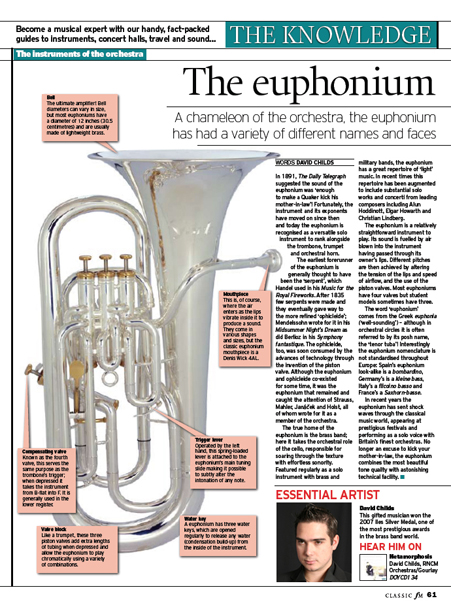
A Chameleon of the orchestra, the euphonium has had a variety of different names and faces.
In 1891 a journalist from the Daily Telegraph suggested the sound of the euphonium was, "enough to make a Quaker kick his mother-in-law"! Fortunately the instrument and its exponents have moved on a great deal since then; today the euphonium is recognised as a versatile solo instrument to rank alongside the trombone, trumpet and orchestral horn.
The earliest forerunner of the euphonium is generally thought to have been the 'serpent' which Handel used in his Music for the Royal Fireworks. After 1835 few serpents were made - they eventually gave way to the more refined 'ophicleide'. Like the serpent, the ophicleide was played with a cupped mouthpiece and produced a deep tone. Mendelssohn wrote for the ophicleide in his Midsummer Night's Dream, as did Berlioz in his Symphony Fantastique. However, the ophicleide was soon consumed by the advances of technology through the invention of the piston valve and although the euphonium and ophicleide co-existed for some time, it is the euphonium which remained and caught the attention of Strauss, Mahler, Janacek and most famously Holst; all of whom wrote for the euphonium as a member of the orchestra.
The true home of the euphonium is the brass band; here it takes the orchestral role of the cello, responsible for soaring through the texture with effortless sonority. Featured as a regular solo instrument with brass and military bands the euphonium has a great repertoire of 'light' music. However, in recent times this repertoire has been augmented to include substantial solo works and concerti from leading composers including Alun Hoddinott, Elgar Howarth, and Christian Lindberg.
The euphonium is a relatively straight-forward instrument to play. Its sound is fuelled by air blown into the instrument having passed through its owner's lips. Different pitches are then achieved by altering the tension of the lips, speed of airflow and the use of the instrument's piston valves. Most euphoniums have four valves, but student models sometimes have three.
The word 'euphonium' derives from the Greek, 'euphonia' meaning well sounding, although in orchestral circles the euphonium is often referred to by its posh name, the 'tenor tuba'! Interestingly the euphonium nomenclature is not standardised throughout Europe. Spain's euphonium look-alike is a 'bombadino', the Germans have a 'kleine bass', Italy a 'flicoino basso' and France a 'Saxhorn-basse'. However, all of these are names for approximately the same valved bugle pitched in Bb with eight feet of conical tubing and the same basic range of four to five octaves depending on who's playing it!
In recent years the euphonium has sent shock waves through the classical world of music, appearing at prestigious festivals and performing as a solo voice with some of Britain's finest orchestras. No longer an excuse for a "Quaker to kick his mother-in-law", the euphonium is capable of combining the most beautiful tone quality with astonishing technical facility.
Body parts!
Mouthpiece - This is of course where the air enters as the lips vibrate inside it to produce a sound. They come in various shapes and sizes, but the classic euphonium mouthpiece is a Denis Wick 4AL.
Compensating valve - Known as the fourth valve, this serves the same purpose as the trombone's trigger; when depressed it takes the instrument from B-flat into F. It is generally used in the lower register.
Bell - The ultimate amplifier! Bell diameters can vary in size, but most euphoniums have a bell diameter of 12 inches and are preferably made using light-weight brass.
Valve block - Like a trumpet, these three piston valves add extra lengths of tubing when depressed and allow the euphonium to play chromatically using a variety of combinations.
Trigger lever - Operated by the left hand, this spring loaded lever is attached to the euphonium's main tuning slide making it possible to subtly alter the intonation of any note.
Water key - A euphonium has three of these: they are keys which are opened regularly to release any water (condensation build-up) from the instrument.
David Childs




